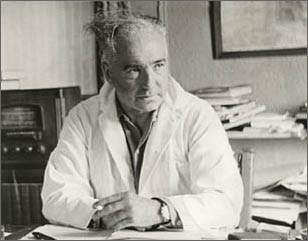
Wilhelm Reich (1897 - 1957) discovered a form of energy that he called "orgone" and asserted that this energy -- which had either been mystified through the ages or rejected outright by modern-day scientists -- could be found within all living things and throughout the cosmos. Reich entered the University of Vienna medical school in 1918 where he as drawn to the work of Sigmund Freud. He quickly became highly respected as a psychiatrist and psychoanalyst.
Reich had a strong impact on Freud, and Freud allowed him to start seeing analytic patients in 1920, when only twenty-three years old, the same year Reich was accepted as a member of the Vienna Psychoanalytic Association. Just a few years later, in 1922, he began his private practice, and became an assistant -- and shortly thereafter the deputy director -- of Freud's Psychoanalytic Polyclinic.
His close relationship with Freud cooled and a rift developed between Reich and the psychoanalytic establishment. This was due, in part, to Reich’s interest in matters outside the strict discipline of psychoanalysis. Reich had become a controversial figure, having placed himself outside the “establishment,” and his original thinking and differing views would keep him outside until his death.
Reich was a remarkably prolific writer, with fifteen books and many other publications to his credit. His Character Analysis, published in 1933, was ground-breaking, as it postulated that a person's overall character, rather than only their symptoms, should be considered when diagnosing and analyzing neurosis. Importantly, it was Character Analysis that introduced the theory of “armoring" where Reich argues that blocked psychosexual energy produces not only emotional illness, but also physical diseases. Reich would continue to hold to his assertion that a healthy sex life is crucial to over-all well being.
In 1939, just prior to the outbreak of World War II, he left Europe for the United States. In 1940, having scientifically proven the existence of orgone energy in the atmosphere, he built the first "orgone accumulator” -- a box-like structure designed to concentrate atmospheric orgone energy. He also conducted trials of the orgone accumulator on patients suffering from a variety of ailments. During the same year Reich wrote to Albert Einstein describing the theoretical basis of orgone energy and the orgone accumulator. He visited the professor in 1941 in Princeton, where they talked for many hours with Einstein agreeing to test the device. The outcome of Reich’s visit with the great man is recorded in the literature dealing with the history of science of Orgonomy.
In 1947 the Food and Drug Administration (FDA) began to investigate Reich’s activities and claims. Some contend that this initial probe into Reich and his work was communist-instigated, undertaken to destroy Reich who had published such compelling, widely read arguments against communism. Others hold that his theories regarding orgone energy, and especially the importance of the function of the orgasm, led to the government’s involvement.
In May 1956, Wilhelm Reich was arrested for violating a court injunction. Without Reich’s knowledge, and against his wishes, an associate intentionally transported orgone energy equipment across state lines. This act resulted in a charge of contempt of court. Reich refused to defend his scientific discoveries in court and was ultimately convicted only of having failed to obey the court’s injunction. He was sentenced to two years in prison. The FDA destroyed Reich’s orgone accumulators and burned, in four separate operations, books and literature. Wilhelm Reich died on November 3, 1957 in the federal penitentiary in Lewisburg, Pennsylvania.
Read Dr. Elsworth F. Baker's brief biography of Wilhelm Reich.
View the Wilhelm Reich Photo Gallery
